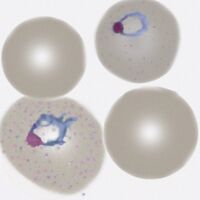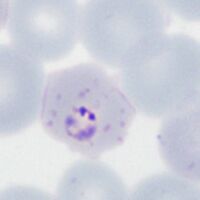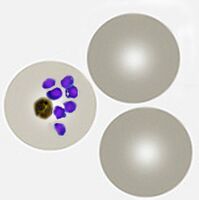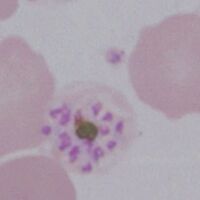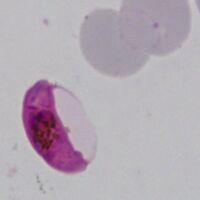Plasmodium vivax: Morphology: Difference between revisions
From haematologyetc.co.uk
No edit summary |
No edit summary |
||
| Line 20: | Line 20: | ||
The earliest ring forms may be indistinguishable from other species, but during this stage the parasite tends to aquire a more irregular forms and to show signs of modification of the erythrocyte (added dots, and altered size and shape). | The earliest ring forms may be indistinguishable from other species, but during this stage the parasite tends to aquire a more irregular forms and to show signs of modification of the erythrocyte (added dots, and altered size and shape). | ||
*erythrocytes begin to show increased [[Red cell size shape|size and altered shape]] | *erythrocytes begin to show increased [[Red cell size and shape|size and altered shape]] | ||
*parasites retain a ring form but may aquire a more irregular form | *parasites retain a ring form but may aquire a more irregular form | ||
*parasites are generally large - occupying up to half of the erythrocyte | *parasites are generally large - occupying up to half of the erythrocyte | ||
Revision as of 09:52, 2 April 2024
Navigation
(click blue highlighted text to return to page)
Malaria main index
>Species identification: summary page
>>This page: P.falciparum: morphology
| The early trophozoite |
- PVET-main image.jpg
The earliest ring forms may be indistinguishable from other species, but during this stage the parasite tends to aquire a more irregular forms and to show signs of modification of the erythrocyte (added dots, and altered size and shape).
- erythrocytes begin to show increased size and altered shape
- parasites retain a ring form but may aquire a more irregular form
- parasites are generally large - occupying up to half of the erythrocyte
- cytoplasmic Schüffner's dots may appear at this stage, although pigment uncommon
| The late trophozoite |
The later growth stage:
- Parasites resemble early ring forms, but are thicker and may be slightly larger
- Additional blue/grey dots and clefts are seen in red cell cytoplasm when stained correctly
- These dots have low number a characteristic "dot" or "line" form Maurer's dots and clefts
- Size and shape of infected red cells is usually unaffected, but may become crenated
- The double dot, accolé, and multiple parasite forms remain present
| The schizont |
The asexual form:
- Do not generally circulate in this species unless overwhelming infection
- The asexually formed developing "merozoites" cluster untidily
- Schizonts develop progressively to form 8-16 merozoites when mature
- In this species the loose malaria pigment may be seen in clumps between the parasites
- Red cell size is generally unaffected but red cells become pale as haemoglobin is metabolised by the parasites
The gametocyte
| The gametocyte |
The sexual replication form (very distinctive).
- Gametocytes are elongated but are restricted into typical shape by the red cell membrane
- They parasites are rod shaped but the membrane may cause them to curve into a “"banana" form”
- The residual membrane (empty of haemoglobin) is often seen as a "blister" to the side of the parasite
- The single chromatin area is in the centre of the parasite, often has pigment overlying it
- Gametocytes may not be be seen, or may be the only form present (particularly after treatment)
- erythrocytes begin to increase size and shape of infected red cells enlarged and distorted during this stage *parasites have a ring form this may be quite irregular *parasites are generally large - occupying up to half of the erythrocyte *cytoplasmic schu8c3bcffneru8e28099s dots may appear at this stage but malaria pigment is not usually seen
the late trophozoite file pvlt.jpg leftt 200px link filepath pvlt.jpg *infected erythrocytes are clearly significantly enlarged and lose their regular outline *parasites are noticeably irregular becoming amoeboid in form *numerous purple schu8c3bcffneru8e28099s dots are seen in the cytoplasm *pigment is often present with irregular distribution
the schizont file pvs.jpg leftt 200px link filepath pvs.jpg *a range of maturing schizonts will generally be present within enlarged red cells *mature schizonts generally contain 16-24 separate merozoites *schu8c3bcffneru8e28099s dots can be detected in any residual cytoplasm of the erythrocyte *pigment is visible in irregularly distributed clumps over the schizont surface
the gametocyte file pvg.jpg leftt 200px link filepath pvg.jpg *very large with ovoid or distorted forms *macrogametocytes female may entirely fill the erythrocyte *microgametocytes male may have a thin cytoplasmic rim with visible schu8c3bcffneru8e28099s dots *pigment is clumped over the surface of the gametocyte
